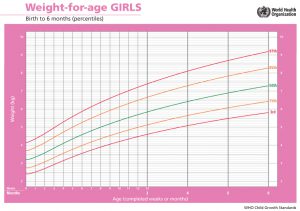There are many parents out there who are under the impression that visits to the pediatrician are strictly for “her shots.” Yet vaccines are only one reason your baby’s provider requests frequent appointment during that first year. In order to ensure your little one’s good health, providers want to know about things such as eating patterns, development (is she doing all the things she should be doing?), and how the family is adjusting. They want to make sure the physical examination is normal and that any potential problems are identified. And as part of a check on her overall health, they want to know whether she is growing properly.
In order to track your baby’s growth, your pediatric office will use a growth chart. At each well visit infants are weighed and their length and head circumference are measured. The nurse or provider will then plot the growth on the chart. The provider can then compare the baby’s size to that of other babies of the same age. The numbers used to compare your baby to others are known as growth percentiles. Brittani Zurek recently gave an excellent explanation of what the growth charts and percentiles mean. Here’s a little more about what pediatricians look for, when they might be concerned, and when they tend not to worry.
Your young one’s provider may show you his growth chart during the first visits, at a few days of age and again at two weeks of age. At that point his growth may not look very impressive, and in fact his “weight for height,” so often looked to as a sign of health in older children, may be off the charts. Don’t worry at this point. Your baby’s weight depends on his gestational age (how early or late he was compared to your due date) as well as other factors that come into play during pregnancy and delivery. Furthermore, babies generally lose up to ten percent of their birth weight during those first few days. Pediatric providers generally look for a climb back up to birth weight by ten days of age, and a steady gain averaging between 2/3 and one ounce a day after that. They also look to see that the baby is eating well, producing regular wet diapers, and acting generally content and happy. However, since so much head growth happens during those first few months, your baby’s provider will look to see that the head circumference is appropriately increasing.
During subsequent visits—say, from two months on—the growth chart becomes more important, and your infant’s pediatrician will look for the growth percentiles to be in the normal range. It’s usually also desirable for the growth to be tracking “along a curve”—that is, the growth percentile should generally not vary much from visit to visit.
Even here, however, there are normal, benign variations. If Mom and Dad are smaller, it’s more likely the baby will be in the lower percentiles. Also, if there is a family history of people maturing on the late side, an infant may be smaller to start out with. This lower percentile may be the case throughout childhood, and even puberty may be a little bit on the late side, but final adult size might be larger than one might predict from earlier growth charts.
Other phenomena can cause variations in growth. Baby growth tends to track according to maternal factors initially. Then, at six to nine months, Dad’s genes come more into play. Thus, if mother and father are of different sizes, percentile-wise, baby’s growth will often be in a different percentile beginning around this time. Finally, growth occurs in steps; thus, your pediatrician may just choose to watch if growth doesn’t seem all that much at a single visit. What providers look for is long-term trends.
OK, then, when might your baby’s provider be concerned? Again, she will ask about feeding, making sure that your little one is getting adequate calories. If there is a question on this, it will raise several others. Is Mom’s breast milk in? If on formula, is it being prepared correctly? And how much is given? During the first few weeks of life, healthy babies need a minimum of two ounces per pound of body weight per day to encourage growth.
Providers will also look for clues to more serious issues. Are there frequent infections? How are the bowel movements? Is there anything on the baby’s physical exam that would provide clues? (Many genetic diseases, for example, will show up with certain features providers can see.) Was the newborn screen—that drop of blood the nurses get on the day of baby’s discharge from the nursery—normal? Is there a family history of any disease that might affect growth? Because there is so much normal variation in growth, the pediatrician may not explore these questions right away, but in the long run, they’d definitely be considered.
The good news is that although monitoring growth is something pediatricians do with every physical, the majority of babies will have normal variations and turn out to grow just fine. But keep going to those checkups—in general, the sooner a problem is discovered, the more effective the treatment will be!

